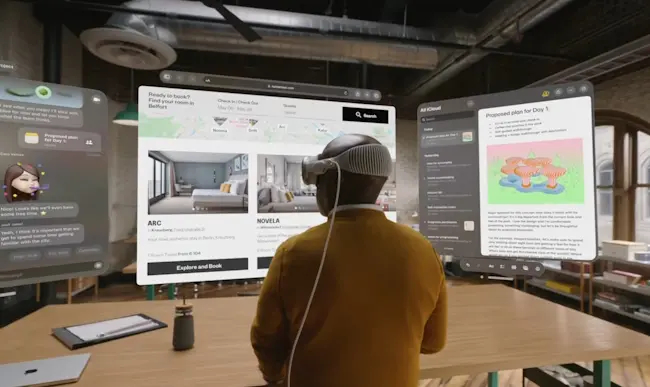
At WWDC 2023, Apple revolutionized computing with the introduction of its Vision Pro headset, featuring the groundbreaking visionOS. This Spatial Computing Operating System is the world’s first, specifically designed to meet the low-latency requirements of spatial computing. It enables users to interact with digital content in a manner that feels physically present in their space. This guide outlines the key features of visionOS, providing an in-depth look at this latest addition to Apple’s impressive lineup of operating systems.
Three Dimensional Interface
The visionOS introduces an entirely new three-dimensional interface, breaking free from the constraints of limited display size. Users can now view their apps side by side in their surroundings, eliminating the need to be confined to the limited screens of traditional devices. This groundbreaking feature allows for the resizing and rearranging of apps according to personal preferences, offering a novel and immersive experience.

Controller-less Input System
VisionOS sets itself apart from other mediocre AR/VR operating systems by revolutionizing the operation of the Vision Pro Headset. Apple’s remarkable controller-less input system eliminates the need for additional hardware components. Interacting with the UI, apps, or other OS elements is seamlessly achieved through the use of vision and fingers.
To engage, users simply direct their gaze towards the app or button in the virtual space. Hovering fingers in the air allows the Vision Pro headset to respond to hand gestures with minimal lag. Further details on the hardware enabling this innovation can be explored in our comprehensive article on the Apple Vision Pro headset.

Redesigned App Store
Accompanying its innovative OS, Apple introduces a redesigned App Store tailored for visionOS, offering discovery of numerous new apps crafted exclusively for the platform. Additionally, users gain access to a vast array of familiar iPhone and iPad apps that seamlessly integrate with the new input system for the Vision Pro headset, ensuring smooth operation.

Immersive Environments
Utilizing Immersive Environments, users can extend their virtual world beyond the confines of their physical space, immersing themselves in dynamic, breathtaking landscapes. These environments serve to enhance focus or declutter busy surroundings, providing a diverse array of scenarios for users to experience.
EyeSight
While VisionOS has catapulted ahead of its competition, the Eyesight feature adds an extra layer of excitement or perhaps a touch of eeriness, depending on your perspective. This feature resonates with a certain Black Mirror episode.
Regarding the Eyesight feature, it ensures that wearers of the Vision Pro headset remain connected with those around them. It achieves this by revealing the user’s eyes, indicating when they are immersed in a virtual experience.

Digital Persona in FaceTime Calls
The Digital Persona is a dynamic and lifelike representation of the user’s face and hand gestures during a FaceTime call, enabling others to see the user even while they are wearing the Vision Pro.
Optic ID: All new Privacy Feature
Like other Apple products, VisionOS is crafted to give users control over the privacy of their data. It introduces a new privacy and security feature called Optic ID, which is a secure authentication system leveraging the uniqueness of the user’s iris.
Siri Is Accessible in visionOS
As an Apple product, VisionOS seamlessly integrates Siri, Apple’s voice assistant system. While wearing the headset, users can simply say “Siri,” and the voice assistant will promptly wake up to perform various tasks.



